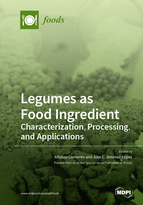Legumes as Food Ingredient: Characterization, Processing, and Applications
A special issue of Foods (ISSN 2304-8158). This special issue belongs to the section "Food Engineering and Technology".
Deadline for manuscript submissions: closed (10 February 2020) | Viewed by 70756
Special Issue Editors
Interests: legumes; sustainability; protein products; nutrition; bioeconomy; food safety
Special Issues, Collections and Topics in MDPI journals
Interests: seed biology; Seed development and germination; seed protein functionality; seed nutraceutic compunds; functional foods; food allergy; seed allergens; molecular tools for allergy diagnosis and therapy
Special Issues, Collections and Topics in MDPI journals
Special Issue Information
Dear colleagues,
Grain legumes like chickpeas, lentils, lupins, peas, cowpeas, and beans, among others, are well-recognized as sources of proteins, starch, fibre, vitamins, and minerals for the human diet, being an essential food crop for people around the globe. They are major ingredients in the Mediteranean diet, playing a vital role in developing countries. Recent advances have been made in unravelling the beneficial effects of legumes beyond meeting basic nutrient requirements. Thus, there is a growing body of scientific evidences regarding the health benefits of some of their bioactive components in inflammatory-related diseases, cardiovascular diseases (CVD), obesity and weight management, type-2 diabetes, and cancer. However, the underlying mechanisms have not been fully clarified.
This Special issue is looking for up-to-date and innovative contributions of scientists working in the following:
a) The nutritional quality and functional properties of legumes and their components;
b) Seed nutraceuticals compounds and their molecular mechanisms for human health improvement;
c) The caracterization of novel legume varieties with enhanced nutritional properties;
d) Global food security;
e) The potential benefits of legume compsumption or their bioactive components in human health;
f) The impact of legume processing such as soaking, dehulling, boiling, autoclaving, microwave cooking, germination, and fermentation in their nutritional and anti-nutritional (i.e., food allergy) properties;
g) The development of novel legume-derived products adapted to consumer preference;
h) Other related topics, in order to provide an updated and global vision of the importance of legumes in human nutrition.
Dr. Alfonso Clemente
Dr. Jose Carlos Jimenez-Lopez
Guest Editors
Manuscript Submission Information
Manuscripts should be submitted online at www.mdpi.com by registering and logging in to this website. Once you are registered, click here to go to the submission form. Manuscripts can be submitted until the deadline. All submissions that pass pre-check are peer-reviewed. Accepted papers will be published continuously in the journal (as soon as accepted) and will be listed together on the special issue website. Research articles, review articles as well as short communications are invited. For planned papers, a title and short abstract (about 100 words) can be sent to the Editorial Office for announcement on this website.
Submitted manuscripts should not have been published previously, nor be under consideration for publication elsewhere (except conference proceedings papers). All manuscripts are thoroughly refereed through a single-blind peer-review process. A guide for authors and other relevant information for submission of manuscripts is available on the Instructions for Authors page. Foods is an international peer-reviewed open access semimonthly journal published by MDPI.
Please visit the Instructions for Authors page before submitting a manuscript. The Article Processing Charge (APC) for publication in this open access journal is 2900 CHF (Swiss Francs). Submitted papers should be well formatted and use good English. Authors may use MDPI's English editing service prior to publication or during author revisions.
Keywords
- Legumes
- Pulses
- Functional foods
- Nutraceuticals
- Nutritional properties
- Health benefits
- Chronic diseases
- Processing
- Novel legume-derived products








